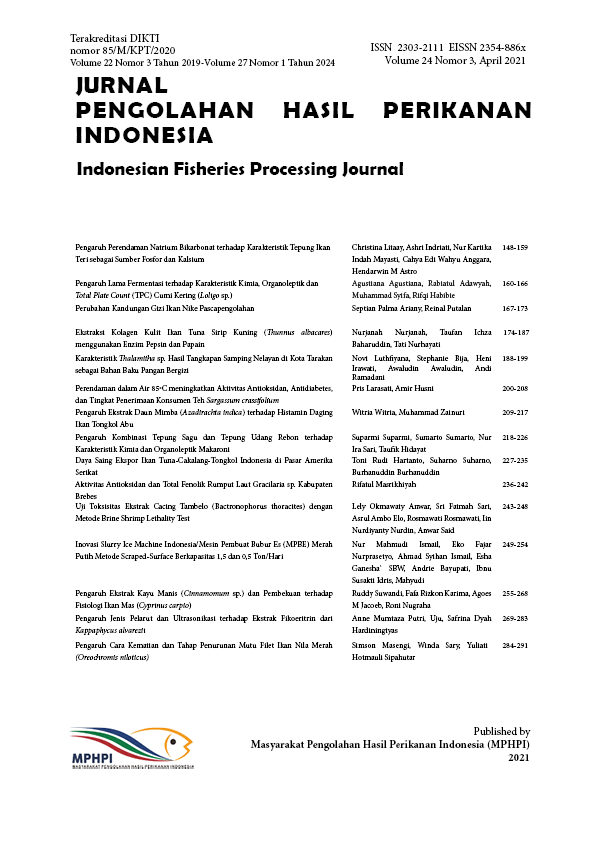Kualitas Gel Pengharum Ruangan Berbahan Dasar Karagenan dan Tepung Sagu dengan Pewangi Jeruk Purut Quality of Gel Fragrance Made of Carrageenan and Sago Flour Scented by Kaffir Lime
Abstract
Everyone needs a comfortable room atmosphere for carrying out activities. For this purpose, air freshener is used. An air freshener that is good for health is an air freshener with natural ingredients. Currently, air freshener in the form of gel is being manufactured for some reason were not spilling, the fragrance is longer binding, easy to use, elastic, and the design easily created. This study aims to make the gel air freshener with a combination of carrageenan and sago starch as a gelling agent and using kaffir lime oil as a fragrance. The research method was the application of a ratio of carrageenan powder and sago powder by 3: 1 and kaffir lime oil concentrations of 0.5%, 1%, and 1.5%. Gelling air freshener with a combination of carrageenan and sago starch as a gelling agent and kaffir lime oil as a fragrance with a concentration of 1.5%, and 1% resulted in the same or the smallest syneresis value and then a concentration of 1.5% had a total evaporation of the liquid in a small number, residual gel weight in a large number, the retention in a large number, and its release in a small number, compared to other treatments, hence, a room freshener by concentration of 1.5% was the best treatment.
References
Abner L, Miftahorrahman. 2002. Keragaman Industri Sagu Indonesia. Warta Penelitian Dan Pengembangan Tanaman Industri. 8 (1). Juni 2002.
Anggadiredja J T, Zatnika A, Purwanto H, dan Istini S. 2006. Rumput Laut. Penerbit Swadaya. Jakarta.
AOAC. 1995. Official Methods of Analysis of the association of official analitycal chemist. Inc.Washington DC.
De Roos, KB. 2009. Effect of Texture and Microstructure on Flavour Retention and Release. Review. International Dairy Journal. 13 (2). 93–105
Fardiaz D. 1989. Hidrokoloid. Bogor : Laboratorium Kimia dan Biokimia Pangan. Pusat Antar Universitas Pangan dan Gizi. Institut Pertanian Bogor.
Fitrah AN. 2013. Formulasi Gel Pengharum Ruangan Menggunakan Karaginan dan Glukomanan Dengan Pewangi Minyak Jeruk Purut dan Kenaga. [Skripsi]. Bogor (ID): Institut Pertanian Bogor.
Gunawan dan Sri. 2004. Ilmu Obat Alam (Farmakologis) Jilid 1. Yogyakarta : Penebar Swadaya
Hargeaves T. (2003). Chemical formulation: An Overview of surfacant-based preparations used in everyday life. England: Royal Society of Chemistry Press.
Hidayat F. (2006). Pengaruh Kombinasi Karagenan Dan Sodium Lauryl Sulfat Serta Penambahan Ekstrak Pemphis acidula Terhadap Karakteristik Sabun Mandi Cair. [Skripsi]. Bogor (ID): Institut Pertanian Bogor.
Kaya, AOW. 2015. Perancangan proses pembuatan gel pengharum ruangan berbasis campuran semirefined carrageenan dan glukomanan dalam pembuatan gel pengharum ruangan. [Disertasi]. Sekolah Pascasarjana Institut Pertanian Bogor.
Mas S. 2013. Pengaruh Penambahan Minyak Nilam sebagai Fiksatif terhadap Ketahanan Wangi Gel Pengharum Ruangan Alami. [Skripsi]. Bogor: Institut Pertanian Bogor.
Naknean P, Meenune, M. 2010. Factors affecting retention and release of flavour compounds in food carbohydrates. Review article. Inter Food Res J. 17: 23-34
Natasasmita, S. 2011. Pengantar evaluasi daging. Fakultas Peternakan. Institut Pertanian Bogor.
Polnaya FJ, Talahatu J, Marseno DW. 2009. Karakteristik Tiga Jenis Pati Sagu (Metroxylon sp.) Hidrosipropil. AGRITECH Majalah Ilmu Dan Teknologi Pertanian, 29 (2): 87-95.
Rahmaisni A. 2011. Aplikasi Minyak Atsiri Pada Produk Gel Pengharum Ruangan Anti Serangga. [Skripsi]. Bogor: Institut Pertanian Bogor.
Sastrohamidjojo H. 2004. Kimia Minyak Atsiri.Yogyakarta : Gadjah Mada University Press.
Van de Velde F, Knutsen SH, Usov AI, Romella HS, Cerezo AS. 2002. IH And 13 C High Resolution NMR Spectoscopy Of Carrageenans: Aplication In Research And Industry, Trend In Food Science And Technology, 13:73-92.
Wahyuni TR. 2016. Formulasi Gel Pengharum Ruangan Menggunakan Karaginan dan Gom Xantan Dengan Minyak Nilam Sebagai Fiksatif Dan Minyak Kenaga Sebagai Pewangi [Skripsi]. Medan (ID) Universitas Sumatera Utara.
Authors

This work is licensed under a Creative Commons Attribution 4.0 International License.
Authors who publish with this journal agree to the following terms:
- Authors retain copyright and grant the journal right of first publication with the work simultaneously licensed under a Creative Commons Attribution License that allows others to share the work with an acknowledgement of the work's authorship and initial publication in this journal.
- Authors are able to enter into separate, additional contractual arrangements for the non-exclusive distribution of the journal's published version of the work (e.g., post it to an institutional repository or publish it in a book), with an acknowledgement of its initial publication in this journal.





